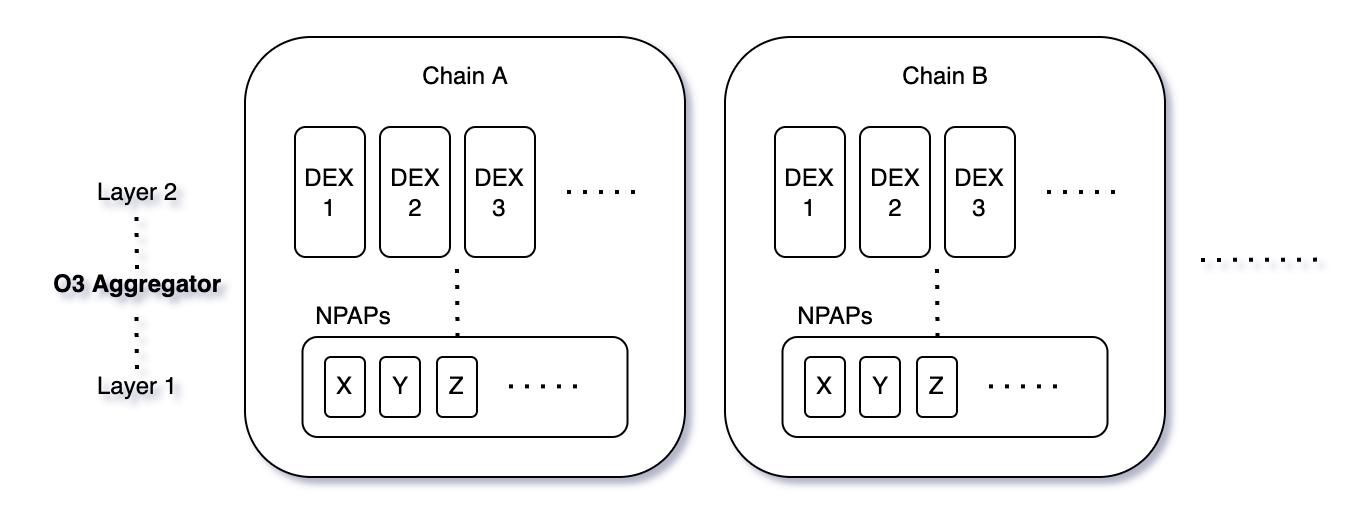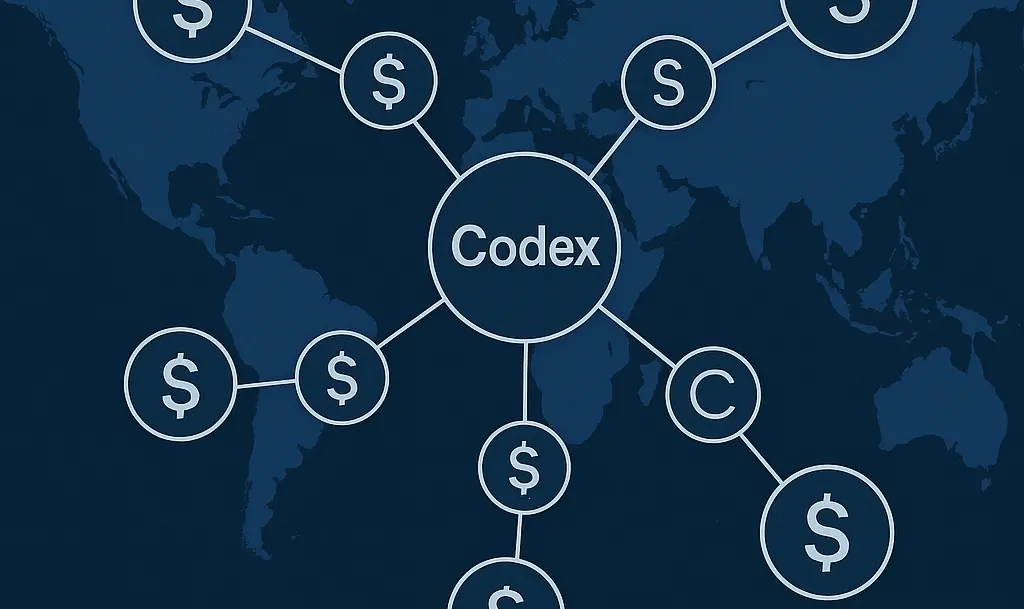Analysis of O3 Interchange: Cross-chain Liquidity Solution
Author: O3 Interchange
O3 Swap V2 - Interchange is the second-generation cross-chain product launched by O3 Labs.
With the emergence of numerous DeFi projects on various new public chains, users inevitably need to transfer and exchange assets across multiple networks, which has led to the rise of many cross-chain protocols.
However, current cross-chain protocols face some trade-off issues. For instance, many analytical articles frequently mention the "trilemma," stating that most cross-chain protocols cannot achieve a good balance among these three demands, and the perfect cross-chain solution is to balance these three difficulties:
1) Universality: Achieving cross-chain transmission of various information;
2) Scalability: Maximizing interoperability across multiple chains and assets with minimal deployment costs;
3) Security: Ensuring the safety of funds without adding excessive trust assumptions, i.e., trustless/minimal trust.
However, we believe that in the era of cross-chain 1.0, the assumptions of the trade-off model are mostly based on the traditional cross-chain communication layer. Thus, even if some optimal balance is achieved in the so-called "trilemma," it still cannot escape its systemic limitations. In contrast, O3 Swap V2 hopes to propose a more dimensional fourth trade-off point—liquidity—from a higher perspective of the cross-chain 2.0 application layer.
In DeFi, liquidity is king. Only with practical operability and trustless native asset liquidity can users truly utilize and hold assets long-term.
In 2021, O3 Labs pioneered the cross-chain liquidity aggregation protocol O3 Swap v1, leading the entire cross-chain 1.0 ecosystem. Since then, O3 Labs has been dedicated to providing users with the best cross-chain experience through liquidity solutions.
Now, in this still challenging three-dimensional cross-chain 1.0 era, O3 Swap V2 will introduce the Cross-Chain Diamond Model that considers the four-dimensional trade-off, ensuring a comprehensive native asset liquidity solution while balancing protocol usability, scalability, and security, thus ushering in the cross-chain 2.0 era.

Under the Cross-Chain Diamond Model, the four dimensions of trade-off are: Security, Universality, Liquidity, and Scalability.
● Ensuring Security of Native Asset Liquidity Solutions through Trustless Mechanisms
Liquidity encompasses two aspects: one is the quantitative requirement, i.e., sufficient support for large transaction volumes; the other is the qualitative requirement, i.e., ensuring the native nature and operability of the target assets.
Before O3 Swap V1, few cross-chain protocols addressed the solution for native asset liquidity. We have always believed that crowdfunding native asset liquidity through yields/incentives and balancing liquidity pools through arbitrage and reward distribution mechanisms is the ultimate solution for liquidity's quality and quantity. Thus, at the beginning of 2021, O3 Swap v1 innovatively introduced the concept of native asset cross-chain pools using Curve's AMM model into the cross-chain field, aggregating multi-chain liquidity into a unified cross-chain pool for global calls by the protocol, achieving seamless cross-chain with unified liquidity.
In this Web3 era, characterized by "open source and openness," we are pleased to see other dApp builders draw experience from our model and continue to build. However, most protocols still encounter challenges in managing native assets and their mapped assets.
Some solutions that involve project parties actively providing market-making for cross-chain funds or managing funds through multi-signature wallets not only struggle to support large transaction volumes but also carry certain centralization risks. The HTLC model, while achieving high security through trustless mechanisms, sacrifices liquidity due to node deployment cost limitations and cannot provide an instant response or single confirmation cross-chain experience. Other protocols use compatible mapped assets as a compromise liquidity solution, allowing assets that originally lack native liquidity on the target chain to obtain a corresponding mapped asset abcX as an IOU certificate, which can be influenced by the source chain asset's backing and thus carries risk in long-term holding.
Therefore, when users transfer asset X from Chain A to Chain B, they must consider whether the received asset on the target chain is the native asset X or its mapped asset abcX. This abcX, whose minting rights are entirely controlled by the project party, not only lacks the operability and rights of native X but also increases trust assumptions regarding its value consensus and the authenticity of redeemable native assets, leading to higher security costs.
Thus, O3 Swap V2 will continue to lead a more advanced NPAP liquidity pool model (nativeToken & peggedToken AMM Pool), which consists of a native asset and its corresponding cross-chain soft asset (the p asset anchored by the O3 protocol) as trading pairs, specifically for exchanging native assets and cross-chain soft assets, ensuring that users receive the native asset X on the target chain without being aware of the existence of pX. pX serves merely as an intermediate soft asset in the cross-chain process, avoiding additional funding security assumptions and contagion risks, and these cross-chain soft assets are minted based on the liquidity of the native assets deposited by users, meaning that the minting rights of the cross-chain soft asset pX are in the hands of users, providing strong consensus and reliability.
Moreover, under the dynamic liquidity incentive mechanism and the arbitrage mechanism between chains and pools, the protocol can balance the funds of each liquidity pool through users' spontaneous arbitrage actions, making the cross-chain process closer to being lossless. It can also optimize the utilization of cross-chain funds and the overall cost-effectiveness of the protocol, rather than simply accumulating excessively high TVL, maximizing the liquidity solution and value capture capability of O3 Swap V2.
● Building a Cross-Chain DEX Based on Ultra-High Scalability and Universality
During the O3 Swap V1 period, the model of concentrating various assets in the same cross-chain liquidity pool, while effectively solving the issue of unified liquidity for native assets, limited later scalability (e.g., the cost of supporting new chains and new assets) and increased certain risk costs.
To address this, we have made disruptive innovations and optimizations in O3 Swap V2, establishing a multi-point parallel security model. In this model, each native asset and its cross-chain soft asset are stored separately in an NPAP, meaning that large risk pools will be effectively isolated and fragmented, reducing the risk cost and security budget of single points of failure through multi-point parallelism.
At the same time, NPAPs across different chains can not only operate independently but also access and call each other. Therefore, as long as we deploy new NPAP liquidity pools on any chain and link them into the protocol's liquidity network, we can efficiently complete cross-chain support for new chains & new assets, achieving high scalability.
The aspiration to "build a cross-chain DEX" was something we envisioned long before launching O3 Swap V1. It remains our goal today, as we see that some issues in the current DeFi landscape have yet to be effectively resolved:
1) There are many excellent DEXs in the market that not only offer convenient interactions but also maintain high liquidity levels. Unfortunately, this liquidity remains isolated and fragmented, lacking good interoperability between chains.
2) Most cross-chain protocols only support same-asset cross-chain, i.e., the Bridge model. The problem this brings is that when a user with asset X on Chain A needs to use asset Y on Chain B for staking, lending, etc., they must perform an additional step to exchange X for Y either before or after the cross-chain process, along with the time and funding costs of finding a DEX that supports the X/Y trading pair. As public chains and DeFi evolve, the Bridge model, which is functionally limited and cannot provide a one-stop solution, will gradually fail to meet the cross-chain needs of most users.
To solve the above challenges, we aim to develop a universal liquidity solution that breaks down barriers between Web3 networks, aggregating DEXs across chains to not only achieve the effects of DEXs in asset trading choices but also provide users with a high-quality DEX-like experience in terms of liquidity and interaction.
Specifically, on O3 Interchange, we will not only have instant confirmation for symmetric asset cross-chain—Bridge—but also support asymmetric asset cross-chain—Swap, with up to five cross-chain paths:
1) Asset X on Chain A swaps for Asset Y on Chain A -- Swap
2) Asset X on Chain A cross-chains to Asset X on Chain B -- Bridge
3) Asset X on Chain A swaps for Asset Y on Chain A via A Chain DEX, then cross-chains to Asset Y on Chain B -- Swap
4) Asset X on Chain A cross-chains to Asset X on Chain B, then swaps for Asset Y on Chain B via B Chain DEX -- Swap / Gas Station
5) Asset X on Chain A swaps for Y, then cross-chains to Asset Y on Chain B, and swaps for Asset Z on Chain B via B Chain DEX -- Swap
In paths 4 and 5, it can be seen that asymmetric asset cross-chain will also provide a good solution to the gas demand issue on the target chain.
The realization of this asymmetric asset cross-chain is made possible by the O3 Aggregator's sequential bridging. When a demand for asymmetric asset cross-chain is read by the O3 Aggregator on the source chain, it will call liquidity from the aggregated DEXs on the source chain based on the demand situation; or relay the demand information to the target chain, where the O3 Aggregator on the target chain will call the corresponding liquidity from the DEXs and obtain the optimal price path through price comparison, which in most cases will offer better pricing advantages than direct exchanges on mainstream DEXs.

In fact, whether for symmetric or asymmetric asset cross-chain, the O3 Aggregator serves an extremely important role as a global network liquidity management unit.
Because for any NPAP of the same asset on any chain, it can be combined with NPAPs on other chains to construct each bridging unit in a one-to-many manner, and any bridging unit can again bridge one or several liquidity pools from DEXs through the O3 Aggregator, achieving high-concurrency asynchronous transmission of liquidity data across chains, forming a vast, multi-chain, multi-DEX interconnected and compatible liquidity network with NPAPs as the first layer and DEXs as the second layer. The balance of any liquidity resources in the entire cross-chain network and global calls can also bring high activity and security to these liquidity resources.
There is no need to deploy excessive NPAPs to cover all cross-chain assets; by bridging a portion of NPAPs to most DEXs, we can radiate the selection of cross-chain assets to a vast range equivalent to the sum of all major DEXs, possessing unlimited scalability, making O3 Swap V2 a true cross-chain DEX.
O3 Swap V2 not only enables cross-chain exchanges between different chains and assets through extremely high active composability but also packages the core protocol code into an SDK open to all dApp builders, allowing for the same ultra-high passive composability to integrate into the entire Web3 ecosystem, enabling builders to organically merge O3's cross-chain protocol with various scenario solutions, leading the entire ecosystem into the cross-chain 2.0 era.
O3 Token Economics
The O3 token will become a crucial part of the entire O3 Interchange, mainly including the following aspects.
● Fees, Buybacks, and Burns
The fees accumulated on the platform will continuously be used for the buyback and burn of circulating O3 tokens, achieving a good token deflation model to better protect the interests of token prices, liquidity providers, and all O3 holders. At the same time, the economic benefits spontaneously generated between cross-chain users and liquidity providers will promote the formation of a virtuous cycle in the entire cross-chain ecosystem.
● Liquidity Incentives
Under the deflation model, the O3 token will have better value consensus, continuously attracting the injection of native asset liquidity through token incentives, providing users with a smoother cross-chain experience closer to being lossless.
● Token Governance
O3 holders can initiate proposals in the Vote section to support new public chains and tokens, as well as adjustments to liquidity pool reward distributions. O3 Labs believes that user participation and influence in the protocol will continuously optimize the execution and effectiveness of the entire protocol in addressing user needs.








